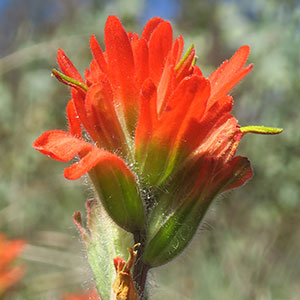Castilleja brevilobata
Castilleja cinerea
short-lobed paintbrush
ash-gray Indian paintbrush, ash-gray paintbrush
solitary or few, erect or ascending, unbranched, sometimes branched, hairs spreading, short, medium, and long, soft, short and medium ones short stipitate-glandular.
several to many, erect to ascending, or decumbent, inflorescence erect in high-elevation form, unbranched, sometimes branched, hairs dense, spreading, ashy gray, short and long, soft, mixed with short stipitate-glandular ones.
green or ± yellow, lanceolate, elliptic, or oblong to narrowly ovate, 1–2(–2.5) cm, not fleshy, margins plane or wavy, involute, (0–)3–5(–7)-lobed, apex rounded to acute;
lobes ascending to erect, linear to lanceolate, apex rounded to acute.
green, brown, purple, or deep gray, linear or narrowly to broadly lanceolate to sometimes ovate, 0.7–3 cm, not fleshy, margins plane, slightly involute, 0(–3)-lobed, apex acuminate;
lobes ascending to spreading, linear to lanceolate, apex acuminate.
3–20 × 2–3.5 cm;
bracts proximally greenish to dull brown, distally red, orange-red, or scarlet, sometimes orange or yellow, broadly lanceolate or oblong, (0–)3–5-lobed;
lobes ascending, broadly to narrowly lanceolate, short, arising above mid length, apex acute, obtuse, or rounded.
1–8.5 × 2–5 cm;
bracts proximally greenish or deep reddish purple, distally burnt orange, sometimes yellow or deep red to deep burgundy, proximal sometimes lanceolate with narrow lobes, distal or all bracts broadly lanceolate to oblong or slightly oblanceolate, (0–)3–5-lobed, appearing dusty with dense, short stipitate-glandular hairs, many with a nodulose to pillarlike, crystallized, usually pigmented exudate, papillose at 40x;
lobes ascending-spreading, oblong or oblanceolate, short, arising above mid length, central lobe apex rounded, often expanded, rounded, or truncate, lateral ones acute to rounded.
straight, 15–24(–26) mm;
tube 12–16 mm;
beak exserted, abaxial lip equal to calyx;
beak adaxially green or ± yellow-green, 7–10 mm, puberulent, stipitate-glandular;
abaxial lip deep green, reduced, rounded, 1–2 mm, 10–25% as long as beak;
teeth incurved to erect, light green, 0.5–1 mm.
straight, 12–18 mm;
tube 9–14 mm;
beak included or tip just barely exserted, adaxially green or pale yellow to deep burgundy, 3–5 mm;
abaxial lip green, burgundy, or reddish purple (in high-elevation form), little inflated, small, included, 2 mm, to 20% as long as beak;
teeth incurved, green, 0.2–0.5 mm.
green or whitish with green veins, lobes colored as bract lobes or paler, 14–30 mm;
abaxial and adaxial clefts 5.5–8.5 mm, 30–40% of calyx length, deeper than laterals, lateral 1.5–4 mm, 20–25% of calyx length;
lobes oblong to narrowly triangular, apex obtuse to rounded.
colored as bracts, sometimes whitish proximally, 1.5–20 mm (shorter in upper elevation form);
abaxial and adaxial clefts 3.5–8 mm, 30–50% of calyx length, all 4 clefts subequal;
lobes linear to narrowly oblong or oblanceolate, apex obtuse to rounded, densely stipitate-glandular.
= 24.
Castilleja brevilobata
Castilleja cinerea
Castilleja brevilobata is endemic to dry serpentine openings in the Siskiyou Mountains of southwestern Oregon and adjacent California. Although sometimes treated as part of C. applegatei or C. hispida, its morphology does not suggest a close connection with either. This species occasionally hybridizes with C. pruinosa in Del Norte County, California.
(Discussion copyrighted by Flora of North America; reprinted with permission.)
Castilleja cinerea is endemic to the higher elevations of the San Bernardino Mountains, San Bernardino County. Most plants are upright to ascending and have yellow to yellow-orange inflorescences, with occasional plants ranging to dull red, especially with age. On Sugarloaf Mountain, mostly above 2700 m, is a distinctive form with consistently reddish purple to burgundy inflorescences and a strongly decumbent growth form.
Castilleja cinerea is most often associated with and likely parasitic on Artemisia nova and Eriogonum species. Castilleja cinerea is known from few populations and is threatened by livestock grazing, development, and vehicle use. It is listed as a threatened species under the Endangered Species Act of the United States.
The crystalline exudate associated with the stipitate-glandular pubescence of the distal portion of the bracts is unique in the genus.
(Discussion copyrighted by Flora of North America; reprinted with permission.)


